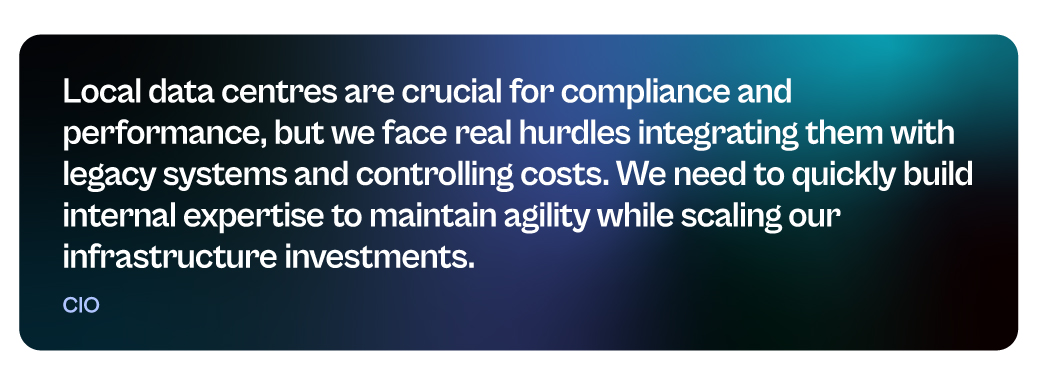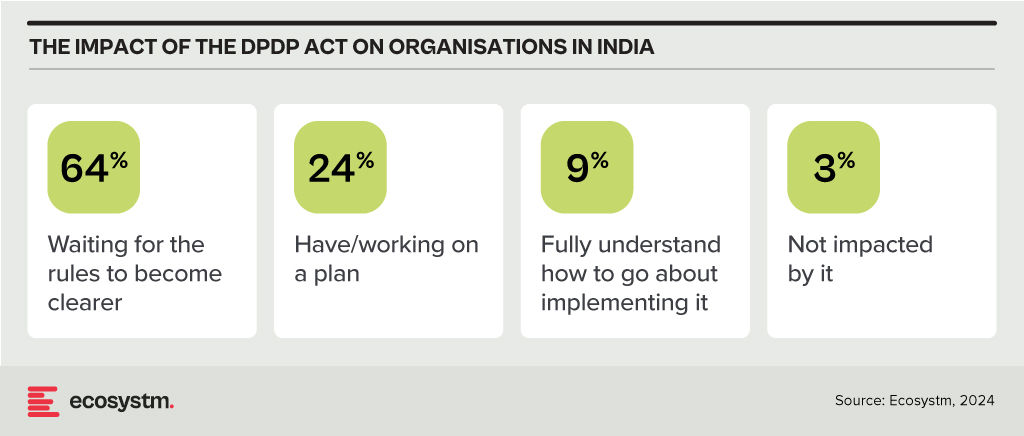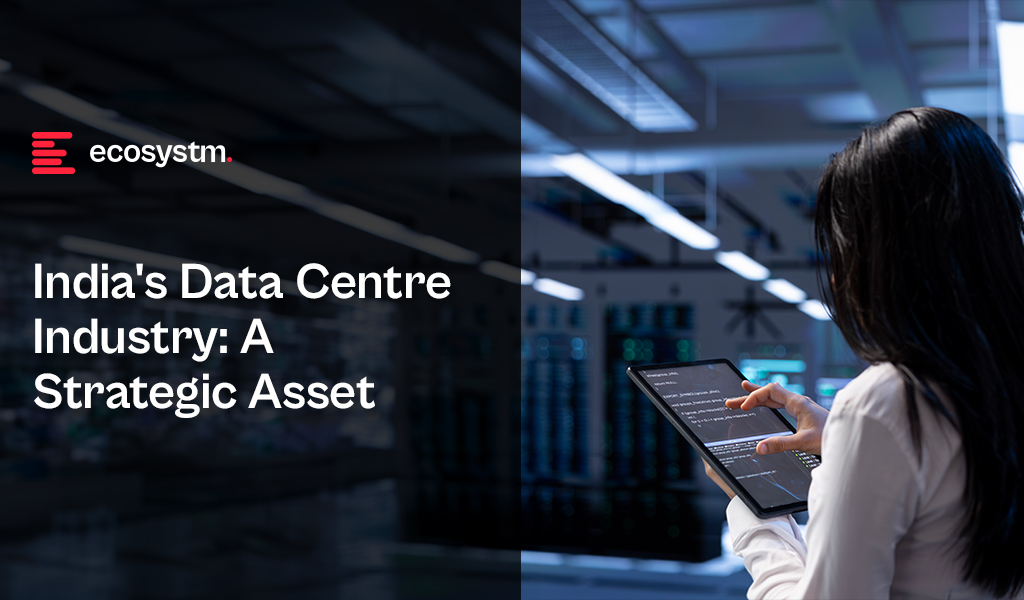India’s rapid digital growth is driven by a unique blend of scale, public infrastructure, and entrepreneurial spirit. The focus is shifting from simply widening access to creating systems that are inclusive, adaptable, and built to last.
What sets India apart is its reliance on open digital platforms tailored to local needs, supported by a mix of government involvement and private-sector innovation. Whether it’s developing multilingual AI, leading product creation for global markets, advancing digital public goods, or pursuing sovereign cloud strategies, India is forging a path shaped by its diversity and growing self-assurance.
Based on Ecosystm’s roundtables and research across India, a distinctive digital model is emerging – one designed to navigate uneven challenges, grounded in practical solutions, and increasingly shaping conversations beyond its borders.
Here are five signals that capture the pulse of India’s digital journey in 2025.
1. Global Design, Local Disruption: The GCC-Driven Tech Surge in India
India’s Global Capability Centres (GCCs) have evolved far beyond their origins as cost-efficient outposts for multinational firms. In 2025, with over 1,600 centres spread across Bengaluru, Hyderabad, Pune, and beyond, GCCs are now designing digital products, AI copilots, and cybersecurity frameworks from the ground up. This transformation is not just redefining global enterprise workflows, it’s reshaping India’s own tech landscape.
As GCCs prototype cutting-edge tools for global banks, retailers, and healthcare systems, their proximity to India’s broader business ecosystem is creating powerful ripple effects. Local startups, mid-sized firms, and even traditional industries are gaining early access to best-in-class practices, technologies, and talent. For example, an AI-driven analytics platform developed for a US-based insurer may be adapted by a healthtech startup in Chennai within months, compressing tech adoption cycles and raising the digital maturity bar across sectors.

This fusion of global exposure and local relevance is accelerating India’s journey toward becoming a product and innovation powerhouse. As GCCs take on more strategic roles, their impact is no longer confined to their parent companies; they’re catalysing a wave of tech-enabled transformation across India’s broader economy.
2. The DPI Effect: Building Smarter, Scaling Faster in India’s Digital Economy
India’s Digital Public Infrastructure (DPI) is quietly powering one of the most inclusive and large-scale technology transformations in the world. While many countries depend on private platforms to deliver digital services, India has taken a distinctly public-first approach – building an open, interoperable digital stack designed for accessibility and scale. With Aadhaar (for identity), UPI (for payments), DigiLocker (for documentation), and the Account Aggregator framework (for secure data sharing) forming its backbone, DPI is not just a convenience but a catalyst for financial inclusion, health access, and rural entrepreneurship.
What sets India’s DPI apart is its dual impact. It empowers citizens while simultaneously accelerating tech adoption across Indian organisations. Enterprises – public and private – are reimagining service delivery, modernising workflows, and launching new offerings by plugging directly into these digital rails. MSMEs use UPI to streamline payments; insurers tap into Account Aggregator for personalised risk assessment; banks leverage Aadhaar for instant customer onboarding. As a result, digital-first operations are no longer limited to tech companies but extends to more traditional businesses.
The shift is as much cultural as it is technical. With trusted public infrastructure in place, startups and enterprises are building with greater confidence and speed, shortening go-to-market cycles and expanding reach. The Open Network for Digital Commerce (ONDC), for example, is enabling kirana stores and small businesses to participate in e-commerce without relying on proprietary platforms, levelling the playing field and accelerating digital inclusion from the ground up.

Global institutions like the World Bank and G20 are now taking note, studying how India’s model blends inclusion, scale, and innovation. In a fragmented digital world, India is showing that public infrastructure can enable private-sector agility and act as a force multiplier for enterprise tech adoption, from startups to state utilities.
3. From Pilots to Performance: India’s Shift Toward Scalable AI Impact
India’s AI journey is entering a critical inflection point. While 76% of organisations now view AI as essential to business success, only 23% have a clear roadmap to implement it, according to Ecosystm research. The gap is no longer about awareness; it’s about execution.
Many Indian enterprises are discovering that without defined outcomes, leadership commitment, and long-term investment in infrastructure and talent, AI efforts stall at the pilot stage. This realisation is shifting focus from experimentation to impact. Forward-looking organisations are starting to anchor AI to core business goals, measuring outcomes in terms of time saved, cost avoided, and revenue generated.

This strategic shift has major implications for India’s tech ecosystem. AI maturity will demand stronger collaboration across product, data, and operations teams; alongside an ecosystem of partners offering open, interoperable, and scalable solutions. It also presents a significant opportunity for Indian tech providers, startups, and systems integrators to support enterprise AI with domain-specific solutions, responsible AI practices, and robust infrastructure capabilities.
4. More Than Translation: India’s AI Accessibility Challenge
While much of the world debates whether AI can code, drive, or write like a human, India is asking a different question: can AI understand and respond like an Indian? With 22 official languages and hundreds of dialects, language is fundamental to access. That’s why India is placing early bets on vernacular AI. Government-led initiatives like Bhashini, under MeitY, are building an open language stack comprising Indic NLP models, regionally sourced datasets, and speech tools optimised for rural and low-literacy users.
This is starting to reshape how Indian organisations design digital experiences. Government services like MyGov and ONDC Saarthi now offer voice-first, multilingual interfaces. Startups such as Reverie, Lokal, and Sarvam are experimenting with models in languages like Hindi, Tamil, and Bengali to power regional content and customer support. The Krutrim LLM, launched recently, represents a step forward, an LLM model trained on Indian data and designed with cultural nuance in mind.
Yet the road ahead isn’t without hurdles. Data sparsity in low-resource languages, the complexity of dialectal variation, and limited commercial incentives for deep vernacular support remain real challenges.

India’s AI journey is being shaped by local priorities, where the next 500 million users coming online will rely more on voice, video, and vernacular than on text or English. That shift is forcing organisations to rethink how they train and deploy AI. The promise is real, but unlocking its full potential will require sustained investment, collaboration, and a deep understanding of linguistic diversity at scale.
5. Building India’s Digital Backbone: The Rise of Local Data Centres
Behind every AI application, mobile transaction, or video stream is a critical but often invisible layer: digital infrastructure. India is currently experiencing one of its largest data centre expansions, with capacity expected to nearly double from around 950 MW today to 1.8 GW by 2026. This growth is driven by rising cloud adoption, data localisation mandates, and increasing demand for AI training and inference within the country.
Companies such as Yotta, AdaniConneX, and Jio are developing hyperscale campuses in Mumbai, Chennai, and Hyderabad, while some state governments are partnering with international firms to build AI-ready, energy-efficient data centres.
For organisations, this expanding infrastructure promises faster access to cloud and AI capabilities, improved latency for critical applications, and compliance with data localisation rules. For organisations, this expanding infrastructure promises faster access to cloud and AI capabilities, improved latency for critical applications, and easier compliance with data localisation rules. However, many face challenges in fully leveraging this growth – navigating the complexity of integrating new infrastructure with legacy systems, managing higher operational costs, and building the in-house expertise required to optimise AI workloads locally.

As India pushes for greater digital sovereignty and infrastructure resilience, the expansion of local data centres will be a crucial factor shaping how organisations innovate and compete in the AI era. Yet realising this potential will require addressing operational challenges alongside building scale.
Designing for Complexity, Delivering for Scale
The future of India’s digital landscape hinges on its ability to convert scale and innovation into sustained, inclusive impact. This requires organisations to move beyond experimentation, integrating new technologies deeply, overcoming legacy constraints, and building local expertise at pace. The race is no longer just about access or capability; it’s about agility, resilience, and leadership in a rapidly evolving global tech environment. How India navigates these challenges will determine whether it merely participates in the digital era or defines it.

India’s digital economy is on a meteoric rise, expected to reach USD 1 trillion by 2025. This surge in digital activity is fuelling the rapid expansion of its data centre market, positioning the country as a global player. With a projected market value of USD 4.5 billion by 2025, India’s data centre industry is set to surpass traditional regional hubs like Malaysia, Hong Kong, and Singapore.
This growth is driven by factors such as the proliferation of smartphones, internet connectivity, and digital services, generating massive amounts of data that need storage and processing. Government initiatives like Digital India and the National e-Governance Plan have promoted digitalisation, while favourable market conditions, including cost-effective infrastructure, skilled talent, and a large domestic market, make India an attractive destination for data centre investments.
As companies continue to invest, India is solidifying its role as a critical hub for Asia’s digital revolution, driving economic development and creating new opportunities for innovation and job creation.
What is Fuelling India’s Data Centre Growth?
India’s data centre industry is experiencing rapid growth in 2024, driven by a combination of strategic advantages and increasing demand. The country’s abundance of land and skilled workforce are key factors contributing to this boom.
- Digitisation push. The digital revolution is fueling the need for more sophisticated data centre infrastructure. The rise of social media, online gaming, and streaming apps has created a surge in demand for faster networks, better data storage options, and increased data centre services.
- Internet and mobile penetration. With 1.1 billion mobile phone subscribers, Indians use an average of 8.3 GB of data per month. As more people come online, businesses need to expand their data infrastructure to handle increased traffic, enhance service delivery, and support a growing digital economy.
- Increasing tech adoption. India’s AI market is projected to reach around USD 17 billion by 2027. As businesses integrate AI, IoT, cloud, and other technologies, data centres will become instrumental in supporting the vast computational and storage requirements.
- Government & regulatory measures. Apart from India being one of the world’s largest data consumption economies, government initiatives have also accelerated the ‘data based’ environment in the country. Additionally, states like Maharashtra, Karnataka, and Tamil Nadu have implemented favourable real estate policies that reduce the costs of setting up data centres.
A Growing Network of Hubs
India’s data centre landscape is rapidly evolving, with major cities and emerging hotspots vying for a piece of the pie.
Mumbai-Navi Mumbai remains the undisputed leader, boasting a combined 39 data centres. Its strategic location with excellent submarine cable connectivity to Europe and Southeast Asia makes it a prime destination for global and domestic players.
Bangalore, India’s IT capital, is not far behind with 29 data centres. The city’s thriving tech ecosystem and skilled talent pool make it an attractive option for businesses looking to set up data centres.
Chennai, located on the east coast, has emerged as a crucial hub with 17 data centres. Its proximity to Southeast Asia and growing digital economy make it a strategic location. The Delhi-NCR region also plays a significant role, with 27 data centres serving the capital and surrounding areas.
Smaller cities like Pune, Jaipur, and Patna are rapidly emerging as data centre hotspots. As businesses seek to serve a growing but distributed user base across India, these cities offer more cost-effective options. Additionally, the rise of edge data centres in these smaller cities is further decentralising the data centre landscape.

A Competitive Market
India ranks 13th globally in the number of operational data centres, with 138 facilities in operation and an additional 45 expected to be completed by the end of 2025. Key initiatives include:
- AWS. AWS is investing USD 12.7 billion to establish four new data centres over the next two years.
- Meta. Meta is set to build a small data centre, potentially focused on cache with a 10-20 MW capacity.
- AdaniConnex. In partnership with EdgeConneX, AdaniConnex aims to develop a 1 GW network of hyperscale data centres over the next decade, all powered by 100% renewable energy.
- Google. Google is set to build an 80-storey data centre by 2025 and is in advanced talks to acquire a 22.5-acre land parcel for its first captive data centre.
- NTT. NTT is investing USD 241 million in a data campus, which will feature three data centres.
Data Centres: Driving Digital India’s Success
The Digital India initiative has transformed government services through improved online infrastructure and increased connectivity. Data centres play a pivotal role in supporting this vision by managing, storing, and processing the vast amounts of data that power essential services like Aadhaar and BharatNet.
Aadhaar, India’s biometric ID system, relies heavily on data centres to store and process biometric information, enabling seamless identification and authentication. BharatNet, the government’s ambitious project to connect rural areas with high-speed internet, also depends on data centres to provide the necessary infrastructure and support.
The impact of data centres on India’s digital transformation is far-reaching. Here are some key areas where data centres have made a significant contribution:
- Enabling Remote Work and Education. Data centres have been instrumental in supporting the surge in remote work and online learning during the pandemic. By providing the necessary infrastructure and connectivity, data centres have ensured business continuity and uninterrupted education.
- Fostering Start-Up Innovation. Data centres provide the essential infrastructure for start-ups to thrive. By offering reliable and scalable computing resources, data centres enable rapid growth and innovation, contributing to the expansion of India’s SaaS market.
- Supporting Government Services. Data centres underpin key government initiatives, including e-governance platforms and digital identity systems. They enhance the accessibility, transparency, and efficiency of government services, bridging the urban-rural divide and improving public service delivery.
Securing India’s Data Centre Future
Data centres are the backbone of India’s digital transformation, fuelling economic growth, government services, innovation, remote work, and technological progress. The Indian government’s ambitious plan to invest over USD 1 billion in hyperscale data centres over the next five years underscores the country’s commitment to building a robust digital infrastructure.
To secure the long-term success of India’s data centre industry, alignment with global standards and strategic investment are crucial. Prioritising reliability, efficiency, and sustainability will attract global providers and position India as a prime destination for digital infrastructure investments. Addressing challenges like legacy upgrades, modernisation, and cybersecurity risks will require collaboration across stakeholders, with government support and technological innovation playing key roles.
A unified effort from central and state governments is vital to enhance competitiveness. By fostering a favourable regulatory environment and offering incentives, the government can accelerate the development of world-class data centres. As India advances digitally, data centres will be instrumental in driving economic growth, improving quality of life, and solidifying India’s status as a global digital leader.

The global data protection landscape is growing increasingly complex. With the proliferation of privacy laws across jurisdictions, organisations face a daunting challenge in ensuring compliance.
From the foundational GDPR, the evolving US state-level regulations, to new regulations in emerging markets, businesses with cross-border presence must navigate a maze of requirements to protect consumer data. This complexity, coupled with the rapid pace of regulatory change, requires proactive and strategic approaches to data management and protection.
GDPR: The Catalyst for Global Data Privacy
At the forefront of this global push for data privacy stands the General Data Protection Regulation (GDPR) – a landmark legislation that has reshaped data governance both within the EU and beyond. It has become a de facto standard for data management, influencing the creation of similar laws in countries like India, China, and regions such as Southeast Asia and the US.
However, the GDPR is evolving to tackle new challenges and incorporate lessons from past data breaches. Amendments aim to enhance enforcement, especially in cross-border cases, expedite complaint handling, and strengthen breach penalties. Amendments to the GDPR in 2024 focus on improving enforcement efficiency. The One-Stop-Shop mechanism will be strengthened for better handling of cross-border data processing, with clearer guidelines for lead supervisory authority and faster information sharing. Deadlines for cross-border decisions will be shortened, and Data Protection Authorities (DPAs) must cooperate more closely. Rules for data transfers to third countries will be clarified, and DPAs will have stronger enforcement powers, including higher fines for non-compliance.
For organisations, these changes mean increased scrutiny and potential penalties due to faster investigations. Improved DPA cooperation can lead to more consistent enforcement across the EU, making it crucial to stay updated and adjust data protection practices. While aiming for more efficient GDPR enforcement, these changes may also increase compliance costs.
GDPR’s Global Impact: Shaping Data Privacy Laws Worldwide
Despite being drafted by the EU, the GDPR has global implications, influencing data privacy laws worldwide, including in Canada and the US.
Canada’s Personal Information Protection and Electronic Documents Act (PIPEDA) governs how the private sector handles personal data, emphasising data minimisation and imposing fines of up to USD 75,000 for non-compliance.
The US data protection landscape is a patchwork of state laws influenced by the GDPR and PIPEDA. The California Privacy Rights Act (CPRA) and other state laws like Virginia’s CDPA and Colorado’s CPA reflect GDPR principles, requiring transparency and limiting data use. Proposed federal legislation, such as the American Data Privacy and Protection Act (ADPPA), aims to establish a national standard similar to PIPEDA.
The GDPR’s impact extends beyond EU borders, significantly influencing data protection laws in non-EU European countries. Countries like Switzerland, Norway, and Iceland have closely aligned their regulations with GDPR to maintain data flows with the EU. Switzerland, for instance, revised its Federal Data Protection Act to ensure compatibility with GDPR standards. The UK, post-Brexit, retained a modified version of GDPR in its domestic law through the UK GDPR and Data Protection Act 2018. Even countries like Serbia and North Macedonia, aspiring for EU membership, have modeled their data protection laws on GDPR principles.
Data Privacy: A Local Flavour in Emerging Markets
Emerging markets are recognising the critical need for robust data protection frameworks. These countries are not just following in the footsteps of established regulations but are creating laws that address their unique economic and cultural contexts while aligning with global standards.
Brazil has over 140 million internet users – the 4th largest in the world. Any data collection or processing within the country is protected by the Lei Geral de Proteção de Dados (or LGPD), even from data processors located outside of Brazil. The LGPD also mandates organisations to appoint a Data Protection Officer (DPO) and establishes the National Data Protection Authority (ANPD) to oversee compliance and enforcement.
Saudi Arabia’s Personal Data Protection Law (PDPL) requires explicit consent for data collection and use, aligning with global norms. However, it is tailored to support Saudi Arabia’s digital transformation goals. The PDPL is overseen by the Saudi Data and Artificial Intelligence Authority (SDAIA), linking data protection with the country’s broader AI and digital innovation initiatives.
Closer Home: Changes in Asia Pacific Regulations
The Asia Pacific region is experiencing a surge in data privacy regulations as countries strive to protect consumer rights and align with global standards.
Japan. Japan’s Act on the Protection of Personal Information (APPI) is set for a major overhaul in 2025. Certified organisations will have more time to report data breaches, while personal data might be used for AI training without consent. Enhanced data rights are also being considered, giving individuals greater control over biometric and children’s data. The government is still contemplating the introduction of administrative fines and collective action rights, though businesses have expressed concerns about potential negative impacts.
South Korea. South Korea has strengthened its data protection laws with significant amendments to the Personal Information Protection Act (PIPA), aiming to provide stronger safeguards for individual personal data. Key changes include stricter consent requirements, mandatory breach notifications within 72 hours, expanded data subject rights, refined data processing guidelines, and robust safeguards for emerging technologies like AI and IoT. There are also increased penalties for non-compliance.
China. China’s Personal Information Protection Law (PIPL) imposes stringent data privacy controls, emphasising user consent, data minimisation, and restricted cross-border data transfers. Severe penalties underscore the nation’s determination to safeguard personal information.
Southeast Asia. Southeast Asian countries are actively enhancing their data privacy landscapes. Singapore’s PDPA mandates breach notifications and increased fines. Malaysia is overhauling its data protection law, while Thailand’s PDPA has also recently come into effect.
Spotlight: India’s DPDP Act
The Digital Personal Data Protection Act, 2023 (DPDP Act), officially notified about a year ago, is anticipated to come into effect soon. This principles-based legislation shares similarities with the GDPR and applies to personal data that identifies individuals, whether collected digitally or digitised later. It excludes data used for personal or domestic purposes, aggregated research data, and publicly available information. The Act adopts GDPR-like territorial rules but does not extend to entities outside India that monitor behaviour within the country.
Consent under the DPDP Act must be free, informed, and specific, with companies required to provide a clear and itemised notice. Unlike the GDPR, the Act permits processing without consent for certain legitimate uses, such as legal obligations or emergencies. It also categorises data fiduciaries based on the volume and sensitivity of the data they handle, imposing additional obligations on significant data fiduciaries while offering exemptions for smaller entities. The Act simplifies cross-border data transfers compared to the GDPR, allowing transfers to all countries unless restricted by the Indian Government. It also provides broad exemptions to the State for data processing under specific conditions. Penalties for breaches are turnover agnostic, with considerations for breach severity and mitigating actions. The full impact of the DPDP Act will be clearer once the rules are finalised and the Board becomes operational, but 97% of Indian organisations acknowledge that it will affect them.

Conclusion
Data breaches pose significant risks to organisations, requiring a strong data protection strategy that combines technology and best practices. Key technological safeguards include encryption, identity access management (IAM), firewalls, data loss prevention (DLP) tools, tokenisation, and endpoint protection platforms (EPP). Along with technology, organisations should adopt best practices such as inventorying and classifying data, minimising data collection, maintaining transparency with customers, providing choices, and developing comprehensive privacy policies. Training employees and designing privacy-focused processes are also essential. By integrating robust technology with informed human practices, organisations can enhance their overall data protection strategy.

The semiconductor industry is 70-years old and has a prominent – and sometimes inconspicuous – presence in our daily lives. Many of us, however, have become more aware of the industry and the ramifications of its disruption, because of recent events. The pandemic, natural disasters, power outages, geo-political conflicts, and accelerated digital transformation have all combined to disrupt the semiconductor sector, leaving no organisation immune to the impacts of the continuing global chip crisis.
It is estimated that 200 downstream industries have failed to fulfill customer demands owing to the silicon scarcity, ranging from automotive, consumer electronics, utilities and even the supply of light fixtures.
This Ecosystm Bytes discusses the impact of the crisis and highlights major initiatives that chip manufacturers and governments are taking to combat it, including:
- The factors leading to the shortage in the semiconductor industry
- The impact on industry sectors such as Automotive, Consumer Electronics and MedTech
- How leading chip makers such as TSMC, Intel and Samsung are increasing their manufacturing capabilities
- The importance of Asia to the semiconductor industry
- How countries such as Malaysia and India are aiming to build self-sufficiency in the industry
Read on to find out more.

ServiceNow announced their intention to acquire robotic process automation (RPA) provider, Intellibot, for an undisclosed sum. Intellibot is a significant tier 2 player in the RPA market, that is rapidly consolidating into the hands of the big three – UiPath, Automation Everywhere, and Blue Prism – and other acquisition-hungry software providers. This is unlikely to be the last RPA acquisition that we see this year with smaller players looking to either go niche or sell out while the market is hot.
Expanding AI/Automation Capabilities
Intellibot is the latest in a string of purchases by ServiceNow that reveals their intention to embed AI and machine learning into offerings. In 2020, they acquired Loom Systems, Passage AI (both January), Sweagle (June), and Element AI (November) in addition to Attivio in 2019. These acquisitions were integrated into the latest version of their Now Platform, code-named Quebec, which was launched earlier this month. As a result, Predictive AIOps and AI Search were newly added to the platform while the low-code tools were expanded upon and became Creator Workflows. This means ServiceNow now offers four primary solutions – IT Workflows, Employee Workflows, Customer Workflows, and Creator Workflows – demonstrating the importance they are placing on low-code and RPA.
ServiceNow was quick to remind the market that although they will be able to offer RPA functionality natively once Intellibot is integrated into their platform, they are still willing to work with competitors. They specifically highlighted that they would continue partnering with UiPath, Automation Anywhere, and Blue Prism, suggesting they plan to use RPA as a complementary technology to their current offerings rather than going head-to-head with the Big Three. Only a month ago, UiPath announced deeper integration with ServiceNow, by expanding automation capabilities for Test Management 2.0 and Agile Development projects.
Expansion in India
The acquisition of Intellibot, based in Hyderabad, is part of ServiceNow’s expansion strategy in India – one of their fastest growing markets. The country is already home to their largest R&D centre outside of the US and they intend to launch a couple of data centres there by March 2022. The company plans to double their local staff levels by 2024, having already tripled the number of employees there in the last two years. The expansion in India means they can increasingly offer services from there to global customers.
Market Consolidation Accelerates
In the Ecosystm Predicts: The Top 5 AI & AUTOMATION Trends for 2021, Ecosystm had talked about technology vendors adding RPA functionality either organically or through acquisitions, this year.
“Buyers will find that many of the automation capabilities that they currently purchase separately will increasingly be integrated in their enterprise applications. This will resolve integration challenges and will be more cost-effective.”
ServiceNow’s purchase is one of several recent examples of low-code vendors acquiring their way into the RPA space. Last year, Appian acquired Novayre Solutions for their Jidoka product and Microsoft snapped up Softomotive. Speculation continues to build that Salesforce could also be assessing RPA targets. Considering RPA market leader, UiPath recently announced that their Series F funding round values the company at USD 35 billion, there is pressure on acquirers to gobble up the remaining smaller players before they are all gone or become prohibitively expensive.
The cloud hyperscalers are also likely to play a growing role in the RPA market over the next year. Microsoft and IBM have already entered the market, coming from the angle of office productivity and business process management (BPM), respectively. Google announced just last week that they will work closely with Automation Anywhere to integrate RPA into their cloud offerings, such as Apigee, AppSheet, and AI Platform. More interestingly, they plan to co-develop new solutions, which might for now satisfy Google’s appetite for RPA rather than requiring an acquisition.
Here are some of the trends to watch for RPA, AI and Automation in 2021. Signup for Free to download Ecosystm’s Top 5 AI & Automation Trends Report.



















